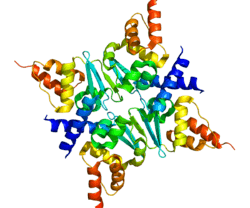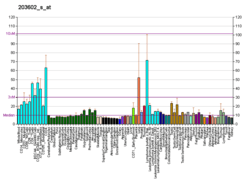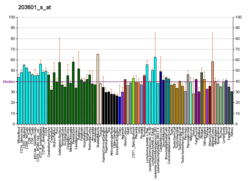ZBTB17
Zinc finger and BTB domain-containing protein 17 is a protein that in humans is encoded by the ZBTB17 gene.[5]
Interactions
ZBTB17 has been shown to interact with TOPBP1,[6] Host cell factor C1[7] and Myc.[8][9]
References
- GRCh38: Ensembl release 89: ENSG00000116809 - Ensembl, May 2017
- GRCm38: Ensembl release 89: ENSMUSG00000006215 - Ensembl, May 2017
- "Human PubMed Reference:". National Center for Biotechnology Information, U.S. National Library of Medicine.
- "Mouse PubMed Reference:". National Center for Biotechnology Information, U.S. National Library of Medicine.
- "Entrez Gene: ZBTB17 zinc finger and BTB domain containing 17".
- Herold S, Wanzel M, Beuger V, Frohme C, Beul D, Hillukkala T, Syvaoja J, Saluz HP, Haenel F, Eilers M (Sep 2002). "Negative regulation of the mammalian UV response by Myc through association with Miz-1". Molecular Cell. 10 (3): 509–21. doi:10.1016/S1097-2765(02)00633-0. PMID 12408820.
- Piluso D, Bilan P, Capone JP (Nov 2002). "Host cell factor-1 interacts with and antagonizes transactivation by the cell cycle regulatory factor Miz-1". The Journal of Biological Chemistry. 277 (48): 46799–808. doi:10.1074/jbc.M206226200. PMID 12244100.
- Staller P, Peukert K, Kiermaier A, Seoane J, Lukas J, Karsunky H, Möröy T, Bartek J, Massagué J, Hänel F, Eilers M (Apr 2001). "Repression of p15INK4b expression by Myc through association with Miz-1". Nature Cell Biology. 3 (4): 392–9. doi:10.1038/35070076. PMID 11283613.
- Peukert K, Staller P, Schneider A, Carmichael G, Hänel F, Eilers M (Sep 1997). "An alternative pathway for gene regulation by Myc". The EMBO Journal. 16 (18): 5672–86. doi:10.1093/emboj/16.18.5672. PMC 1170199. PMID 9312026.
Further reading
- Lichter P, Bray P, Ried T, Dawid IB, Ward DC (Aug 1992). "Clustering of C2-H2 zinc finger motif sequences within telomeric and fragile site regions of human chromosomes". Genomics. 13 (4): 999–1007. doi:10.1016/0888-7543(92)90013-I. PMID 1505991.
- Bray P, Lichter P, Thiesen HJ, Ward DC, Dawid IB (Nov 1991). "Characterization and mapping of human genes encoding zinc finger proteins". Proceedings of the National Academy of Sciences of the United States of America. 88 (21): 9563–7. doi:10.1073/pnas.88.21.9563. PMC 52758. PMID 1946370.
- Tommerup N, Vissing H (May 1995). "Isolation and fine mapping of 16 novel human zinc finger-encoding cDNAs identify putative candidate genes for developmental and malignant disorders". Genomics. 27 (2): 259–64. doi:10.1006/geno.1995.1040. PMID 7557990.
- Maruyama K, Sugano S (Jan 1994). "Oligo-capping: a simple method to replace the cap structure of eukaryotic mRNAs with oligoribonucleotides". Gene. 138 (1–2): 171–4. doi:10.1016/0378-1119(94)90802-8. PMID 8125298.
- Wu L, Wu H, Ma L, Sangiorgi F, Wu N, Bell JR, Lyons GE, Maxson R (Jul 1997). "Miz1, a novel zinc finger transcription factor that interacts with Msx2 and enhances its affinity for DNA". Mechanisms of Development. 65 (1–2): 3–17. doi:10.1016/S0925-4773(97)00032-4. PMID 9256341.
- Schneider A, Peukert K, Eilers M, Hänel F (1997). "Association of Myc with the zinc-finger protein Miz-1 defines a novel pathway for gene regulation by Myc". Current Topics in Microbiology and Immunology. 224: 137–46. doi:10.1007/978-3-642-60801-8_14. ISBN 978-3-642-64560-0. PMID 9308237.
- Peukert K, Staller P, Schneider A, Carmichael G, Hänel F, Eilers M (Sep 1997). "An alternative pathway for gene regulation by Myc". The EMBO Journal. 16 (18): 5672–86. doi:10.1093/emboj/16.18.5672. PMC 1170199. PMID 9312026.
- Suzuki Y, Yoshitomo-Nakagawa K, Maruyama K, Suyama A, Sugano S (Oct 1997). "Construction and characterization of a full length-enriched and a 5'-end-enriched cDNA library". Gene. 200 (1–2): 149–56. doi:10.1016/S0378-1119(97)00411-3. PMID 9373149.
- Sui D, Wilson JE (Oct 2000). "Interaction of insulin-like growth factor binding protein-4, Miz-1, leptin, lipocalin-type prostaglandin D synthase, and granulin precursor with the N-terminal half of type III hexokinase". Archives of Biochemistry and Biophysics. 382 (2): 262–74. doi:10.1006/abbi.2000.2019. PMID 11068878.
- Staller P, Peukert K, Kiermaier A, Seoane J, Lukas J, Karsunky H, Möröy T, Bartek J, Massagué J, Hänel F, Eilers M (Apr 2001). "Repression of p15INK4b expression by Myc through association with Miz-1". Nature Cell Biology. 3 (4): 392–9. doi:10.1038/35070076. PMID 11283613.
- Ziegelbauer J, Shan B, Yager D, Larabell C, Hoffmann B, Tjian R (Aug 2001). "Transcription factor MIZ-1 is regulated via microtubule association". Molecular Cell. 8 (2): 339–49. doi:10.1016/S1097-2765(01)00313-6. PMID 11545736.
- Tussie-Luna MI, Michel B, Hakre S, Roy AL (Nov 2002). "The SUMO ubiquitin-protein isopeptide ligase family member Miz1/PIASxbeta /Siz2 is a transcriptional cofactor for TFII-I". The Journal of Biological Chemistry. 277 (45): 43185–93. doi:10.1074/jbc.M207635200. PMID 12193603.
- Piluso D, Bilan P, Capone JP (Nov 2002). "Host cell factor-1 interacts with and antagonizes transactivation by the cell cycle regulatory factor Miz-1". The Journal of Biological Chemistry. 277 (48): 46799–808. doi:10.1074/jbc.M206226200. PMID 12244100.
- Zhang H, Li Z, Viklund EK, Strömblad S (Sep 2002). "P21-activated kinase 4 interacts with integrin alpha v beta 5 and regulates alpha v beta 5-mediated cell migration". The Journal of Cell Biology. 158 (7): 1287–97. doi:10.1083/jcb.200207008. PMC 2173231. PMID 12356872.
- Herold S, Wanzel M, Beuger V, Frohme C, Beul D, Hillukkala T, Syvaoja J, Saluz HP, Haenel F, Eilers M (Sep 2002). "Negative regulation of the mammalian UV response by Myc through association with Miz-1". Molecular Cell. 10 (3): 509–21. doi:10.1016/S1097-2765(02)00633-0. PMID 12408820.
- Wu S, Cetinkaya C, Munoz-Alonso MJ, von der Lehr N, Bahram F, Beuger V, Eilers M, Leon J, Larsson LG (Jan 2003). "Myc represses differentiation-induced p21CIP1 expression via Miz-1-dependent interaction with the p21 core promoter". Oncogene. 22 (3): 351–60. doi:10.1038/sj.onc.1206145. PMID 12545156.
- Bowen H, Lapham A, Phillips E, Yeung I, Alter-Koltunoff M, Levi BZ, Perry VH, Mann DA, Barton CH (Sep 2003). "Characterization of the murine Nramp1 promoter: requirements for transactivation by Miz-1". The Journal of Biological Chemistry. 278 (38): 36017–26. doi:10.1074/jbc.M304301200. PMID 12840021.
- Sakurai T, Itoh K, Higashitsuji H, Nagao T, Nonoguchi K, Chiba T, Fujita J (Apr 2004). "A cleaved form of MAGE-A4 binds to Miz-1 and induces apoptosis in human cells". The Journal of Biological Chemistry. 279 (15): 15505–14. doi:10.1074/jbc.M310437200. PMID 14739298.
- Lehner B, Sanderson CM (Jul 2004). "A protein interaction framework for human mRNA degradation". Genome Research. 14 (7): 1315–23. doi:10.1101/gr.2122004. PMC 442147. PMID 15231747.
External links
- ZBTB17+protein,+human at the US National Library of Medicine Medical Subject Headings (MeSH)
- Overview of all the structural information available in the PDB for UniProt: Q13105 (Zinc finger and BTB domain-containing protein 17) at the PDBe-KB.
This article incorporates text from the United States National Library of Medicine, which is in the public domain.
This article is issued from Wikipedia. The text is licensed under Creative Commons - Attribution - Sharealike. Additional terms may apply for the media files.






